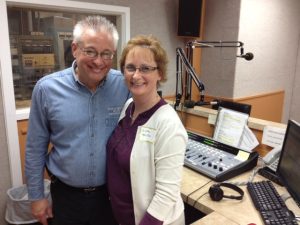Taylorville’s Randy Miller Appreciates Quality Care Close to Home
 Randy Miller’s family history included a worrisome heart pattern. The 70-year-old’s father died of congestive heart failure, and he had two uncles who dealt with heart issues as well.
Randy Miller’s family history included a worrisome heart pattern. The 70-year-old’s father died of congestive heart failure, and he had two uncles who dealt with heart issues as well.
So he didn’t protest when Roger McClintock, MD, an internist with Springfield Clinic in Taylorville, proactively scheduled him for an outpatient cardiac nuclear stress test at Taylorville Memorial Hospital (TMH) this past summer.
“I was out the door in an hour and a half,” he said. “To me, that’s yet another example of the professionalism at Taylorville Memorial Hospital and the way they take care of patients whether it is outpatient or another area. They know what they are doing, and they get it done.”
The convenience of being able to take care of healthcare needs close to home was key for him.
“I thank God that Memorial invested in a brand-new hospital here in Taylorville,” he said. “They saw that the population was aging, and we were going to need more services. What they have is what we need in terms of specialists, ED and diagnosis stuff.”
What IS a Nuclear Stress Test?
According to Fran Bruenderman, CNMT RT(R)(CT)(N), a nuclear medicine technologist with TMH, a nuclear stress test is a relatively simple and noninvasive way to evaluate the heart’s blood flow from the coronary arteries.
“A nuclear stress test allows us to establish whether a patient has blockages or needs further cardiac intervention,” Bruenderman said. “The process involves starting an IV and administering a nuclear medicine or ‘tracer’ that makes its way to the heart muscle, followed by an image on a camera. The tracer doesn’t have any side effects, but it does take a while to circulate before imaging.”
After the baseline image is taken, the cardiology team connects the patient to a continuous EKG machine with patches, wires, a blood pressure cuff and pulse oxygen monitor. Then, the patient either walks on the treadmill or receives a medication that internally mimics exercise. After the stress test, the patient returns to nuclear medicine for another scan.
The Process
For Miller, the first part – the stick for the IV – was very important.
After the recording of his heart at rest, Miller was off to the treadmill. He started running and they did the second injection of the radioactive substance through his IV while he was on the treadmill.
 Miller likened the treadmill workout to the I Love Lucy! factory episode where the chocolates keep coming faster and faster on the conveyor belt.
Miller likened the treadmill workout to the I Love Lucy! factory episode where the chocolates keep coming faster and faster on the conveyor belt.
“It started out walking with some running,” he said. “Then it was time to ‘Speed it up!’ so they could get a good picture.”
Once the treadmill tests were completed, he went back to nuclear medicine for one more reading. He was in good shape, and the tests revealed no issues.
It was just what he was hoping to hear ahead of retirement after 43 years as an area radio station owner, the past 33 in Taylorville. Today, he enjoys spending more time with his wife, Cathy, three daughters and six grandchildren. Staying healthy is a big part of that.
“You’ve got to have a good hospital to attract people to a county or a community,” Miller added. “We have that, and I’m grateful.”